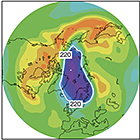The planet’s protective ozone layer is in far better shape today thanks to the United Nations’ Montreal Protocol, which came
into force in 1987 and restricted the use of ozone-depleting substances such as CFCs, according to a new study in Nature Communications. The researchers used 3D atmospheric chemistry modeling to look at what might have happened to the ozone layer had the treaty not been implemented. The findings suggest that the Antarctic ozone hole would have grown by an additional 40 percent by 2013 and, had ozone-depleting substances continued to increase, the ozone layer would have become significantly thinner over other parts of the globe. A very large ozone hole over the Arctic would have occurred during the exceptionally cold Arctic winter of 2010-2011 — colder temperatures cause more loss — and smaller Arctic ozone holes would have become a regular occurrence.
Enlarge
Ozone hole without the Montreal Protocol